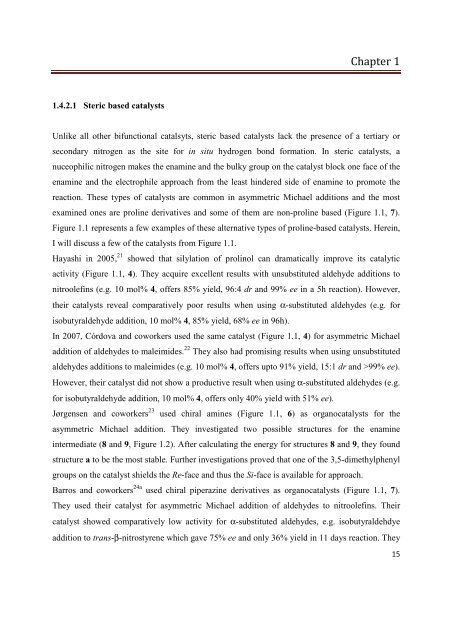Ph.D. Thesis_AS_Publishing version for IRC_12 ... - Jacobs University
Ph.D. Thesis_AS_Publishing version for IRC_12 ... - Jacobs University
Ph.D. Thesis_AS_Publishing version for IRC_12 ... - Jacobs University
Create successful ePaper yourself
Turn your PDF publications into a flip-book with our unique Google optimized e-Paper software.
Chapter 1<br />
1.4.2.1 Steric based catalysts<br />
Unlike all other bifunctional catalsyts, steric based catalysts lack the presence of a tertiary or<br />
secondary nitrogen as the site <strong>for</strong> in situ hydrogen bond <strong>for</strong>mation. In steric catalysts, a<br />
nuceophilic nitrogen makes the enamine and the bulky group on the catalyst block one face of the<br />
enamine and the electrophile approach from the least hindered side of enamine to promote the<br />
reaction. These types of catalysts are common in asymmetric Michael additions and the most<br />
examined ones are proline derivatives and some of them are non-proline based (Figure 1.1, 7).<br />
Figure 1.1 represents a few examples of these alternative types of proline-based catalysts. Herein,<br />
I will discuss a few of the catalysts from Figure 1.1.<br />
Hayashi in 2005, 21 showed that silylation of prolinol can dramatically improve its catalytic<br />
activity (Figure 1.1, 4). They acquire excellent results with unsubstituted aldehyde additions to<br />
nitroolefins (e.g. 10 mol% 4, offers 85% yield, 96:4 dr and 99% ee in a 5h reaction). However,<br />
their catalysts reveal comparatively poor results when using α-substituted aldehydes (e.g. <strong>for</strong><br />
isobutyraldehyde addition, 10 mol% 4, 85% yield, 68% ee in 96h).<br />
In 2007, Córdova and coworkers used the same catalyst (Figure 1.1, 4) <strong>for</strong> asymmetric Michael<br />
addition of aldehydes to maleimides. 22 They also had promising results when using unsubstituted<br />
aldehydes additions to maleimides (e.g. 10 mol% 4, offers upto 91% yield, 15:1 dr and >99% ee).<br />
However, their catalyst did not show a productive result when using α-substituted aldehydes (e.g.<br />
<strong>for</strong> isobutyraldehyde addition, 10 mol% 4, offers only 40% yield with 51% ee).<br />
Jørgensen and coworkers 23 used chiral amines (Figure 1.1, 6) as organocatalysts <strong>for</strong> the<br />
asymmetric Michael addition. They investigated two possible structures <strong>for</strong> the enamine<br />
intermediate (8 and 9, Figure 1.2). After calculating the energy <strong>for</strong> structures 8 and 9, they found<br />
structure a to be the most stable. Further investigations proved that one of the 3,5-dimethylphenyl<br />
groups on the catalyst shields the Re-face and thus the Si-face is available <strong>for</strong> approach.<br />
Barros and coworkers 24a used chiral piperazine derivatives as organocatalysts (Figure 1.1, 7).<br />
They used their catalyst <strong>for</strong> asymmetric Michael addition of aldehydes to nitroolefins. Their<br />
catalyst showed comparatively low activity <strong>for</strong> α-substituted aldehydes, e.g. isobutyraldehdye<br />
addition to trans-β-nitrostyrene which gave 75% ee and only 36% yield in 11 days reaction. They<br />
15

















